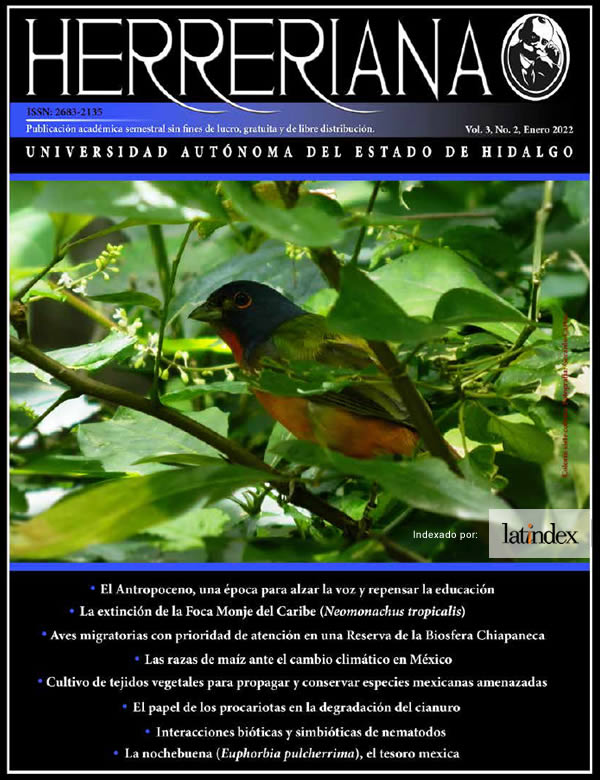Cultivo de tejidos vegetales para propagar y conservar especies mexicanas amenazadas
Culturing plant tissue to propagate and conserve threatened Mexican species
DOI:
https://doi.org/10.29057/h.v3i2.8096Keywords:
Propagation, conservation, biodiversity, floraAbstract
Mexico is classified as a megadiverse country, as it has wide biological and cultural diversity, it also stands out as one of the countries that are center of origin and domestication of important plants, having in the national territory between 10-12% of all species of the world, and of these 50-60% are endemic. Unfortunately, much of this biological wealth is subject to special protection, threatened or in danger of extinction. Plant tissue culture is a biotechnological tool that allows obtaining plants quickly, efficiently and in large quantities, becoming a strategy to mitigate the problems faced by some species. Therefore, the use of science and technology in the recovery of Mexican species is important, as well as promoting their study, propagation and conservation in order to make proposals for the sustainable use of the Mexican flora.
Downloads
Publication Facts
Reviewer profiles N/A
Author statements
Indexed in
- Academic society
- N/A
- Publisher
- Universidad Autónoma del Estado de Hidalgo
References
Cabrera-Hilerio, S., Chávez-Ávila, V., Sandoval-Zapotitla, E., et al. 2008. Morfogénesis in vitro de Dioon merolae de Luca, Sabato & Vázquez-Torres (Zamiaceae, Cycadales) a partir de megagametofitos y embriones cigóticos. Interciencia, 33 (12): 929-934. Recuperado de http://ve.scielo.org/scielo.php?script=sci_arttext&pid=S037818442008001200013&lng=es&tlng=es.
Castelán-Culebro, S., Franceschy-Ronzón, C. & Menchaca-García, R. 2020a. Extracto de vainilla ¿Natural o sintético? Vainilla de México para el mundo. Centro de Investigaciones Tropicales, Universidad Veracruzana, México.
Castelán-Culebro, S., Franceschy-Ronzón, C. & Menchaca-García, R. 2020b. La vainilla: más allá de su sabor. Vainilla de México para el mundo. Centro de Investigaciones Tropicales, Universidad Veracruzana, México.
Chávez-Ávila, V. 2014. Cultivan en la UNAM tejidos vegetales para conservar plantas mexicanas en peligro de extinción. Recuperado de https://www.dgcs.unam.mx/boletin/bdboletin/2014_010.html
Domínguez-Rosales, M. S., González-Jiménez, M., Rosales-Gómez, C., et al. 2008. El cultivo in vitro como herramienta para el aprovechamiento, mejoramiento y conservación de especies del género Agave. Investigación y Ciencia, 16 (41): 53-62.
Nicolande-Morejón, F. & Martínez-Domínguez, L.2017. Las cícadas, habitantes del Jurásico. En La ciencia y el hombre, Universidad Veracruzana, 3(30). México, pp34-39
Ramírez-Mosqueda, M., Iglesias-Andreu, L., Noa-Carranza, J., & Armas-Silva, A. 2018. Selección de genotipos de Vanilla planifolia Jacks. ex Andrews resistente a Fusarium oxysporum f. sp. Vanillae, mediante biotecnología. Agroproductividad, 11(3), 70-74.
SEMARNAT. 2010. Norma Oficial Mexicana NOM-059-SEMARNAT-2010, Protección ambiental Especies nativas de México de flora y fauna silvestres Categorías de riesgo y especificaciones para su inclusión, exclusión o cambio Lista de especies en riesgo. Diario Oficial de la Federación. Recuperado de: https://biblioteca.semarnat.gob.mx/janium/Documentos/Ciga/agenda/DOFsr/DO2454.pdf
SEMARNAT. 2012. Biodiversidad. En SEMARNAT (ed. 2012) Informe de la situación del medio ambiente en México, México, p. 156–167. Recuperado de https://apps1.semarnat.gob.mx:8443/dgeia/informe_12/pdf/Cap4_biodiversidad.pdf
Trejo-Hernández, L., Martínez-Rendón, A. y López-Escamilla, A. 2016. Apoya la UNAM a comunidades de Tlaxcala a rescatar cultivos de agave. Boletín UNAM-DGCS-492. Ciudad Universitaria. Recuperado de https://www.dgcs.unam.mx/boletin/bdboletin/2016_492.html


















